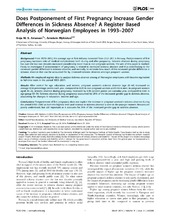| dc.contributor.author | Ariansen, Anja Maria Steinsland | eng |
| dc.contributor.author | Mykletun, Arnstein | eng |
| dc.date.accessioned | 2014-12-02T13:32:03Z | |
| dc.date.available | 2014-12-02T13:32:03Z | |
| dc.date.issued | 2014-03-25 | eng |
| dc.identifier.issn | 1932-6203 | |
| dc.identifier.uri | https://hdl.handle.net/1956/8804 | |
| dc.description.abstract | Background: From 1970–2012, the average age at first delivery increased from 23.2–28.5 in Norway. Postponement of first pregnancy increases risks of medical complications both during and after pregnancy. Sickness absence during pregnancy has over the last two decades increased considerably more than in non-pregnant women. The aim of this paper is twofold: Firstly to investigate if postponement of pregnancy is related to increased sickness absence and thus contributing to the increased gender difference in sickness absence; and secondly, to estimate how much of the increased gender difference in sickness absence that can be accounted for by increased sickness absence amongst pregnant women. Methods: We employed registry-data to analyse sickness absence among all Norwegian employees with income equivalent to full-time work in the period 1993–2007. Results: After control for age, education, and income, pregnant women’s sickness absence (age 20–44) increased on average 0.94 percentage points each year, compared to 0.29 in non-pregnant women and 0.14 in men. In pregnant women aged 20–24, sickness absence during pregnancy increased by 0.96 percent points per calendar year, compared to 0.60 in age-group 30–34. Sickness absence during pregnancy accounted for 25% of the increased gender gap in sickness absence, accounting for changes in education, income and age. Conclusions: Postponement of first pregnancy does not explain the increase in pregnant women’s sickness absence during the period 1993–2007 as both the highest level and increase in sickness absence is seen in the younger women. Reasons are poorly understood, but still important as it accounts for 25% of the increased gender gap in sickness absence. | en_US |
| dc.language.iso | eng | eng |
| dc.publisher | PLoS | eng |
| dc.relation.ispartof | <a href="http://hdl.handle.net/1956/15705" target="_blank">Women’s sickness absence in contemporary Norway. The impacts of class, motherhood, and pregnancy</a> | |
| dc.rights | Attribution CC BY | eng |
| dc.rights.uri | http://creativecommons.org/licenses/by/4.0 | eng |
| dc.title | Does Postponement of First Pregnancy Increase Gender Differences in Sickness Absence? A Register Based Analysis of Norwegian Employees in 1993–2007 | eng |
| dc.type | Peer reviewed | en_US |
| dc.type | Journal article | en_US |
| dc.description.version | publishedVersion | |
| dc.rights.holder | Copyright 2014 Ariansen, Mykletun | en_US |
| dc.source.articlenumber | e93006 | |
| dc.identifier.doi | https://doi.org/10.1371/journal.pone.0093006 | |
| dc.identifier.cristin | 1126709 | |
| dc.source.journal | PLoS ONE | |
| dc.source.40 | 9 | |
| dc.source.14 | 3 | |
| dc.subject.nsi | VDP::Samfunnsvitenskap: 200::Sosiologi: 220 | nob |

